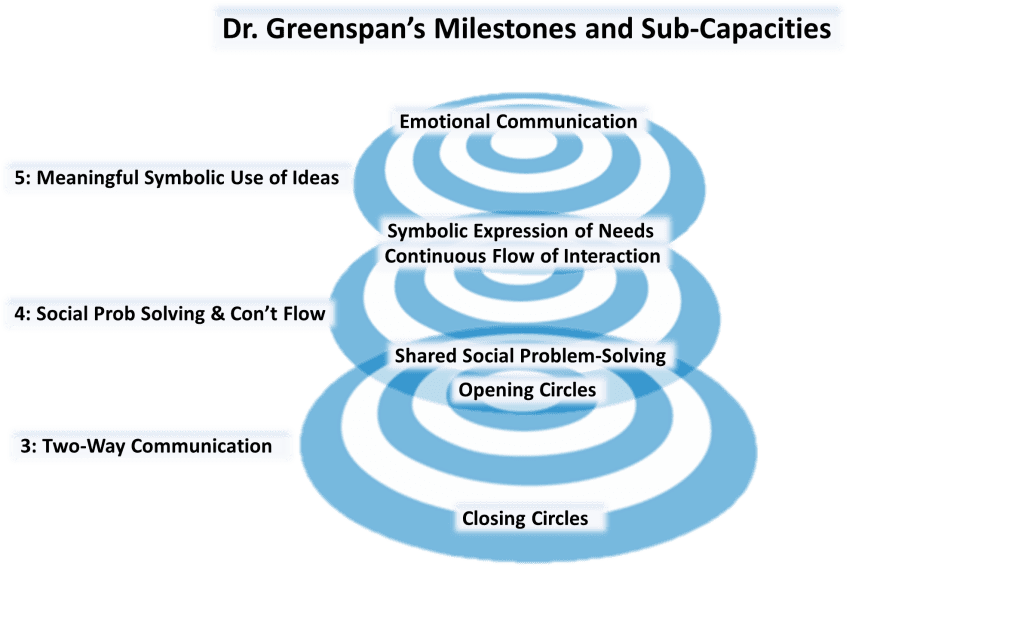The Greenspan/DIR™ Model and Greenspan Floortime® are Strength-Based
**Stanley I Greenspan MD Inc. does not support ICDL or its DIRFloortime.
Dr. Greenspan’s Greenspan/DIR™ Model draws inspiration from Piaget’s concept of progressive development, emphasizing the building blocks of child development. Throughout his 40 books, he uses “Milestones,” “Levels,” and “Stages” to illustrate how children grow by achieving increasingly complex skills, with each step rooted in earlier progress. This strength-based framework highlights the positive trajectory of child development.
In contrast, some non-Greenspan/DIR approaches focus solely on “Capacities,” which describes a child’s abilities without explicitly recognizing the sequential nature of development and the interconnectedness of skills. This difference between the use of “Milestones” and “Capacities” reflects a different perspective on how children learn and grow, and the sole use of “Capacities” does not describe a strength-based framework.
An example of this strength-based feature of Dr. Greenspan’s framework is how we use his Milestones to describe a child’s individual profile and support their optimal social, emotional, and cognitive development/growth. One of the most common and observable developmentally progressive moments is when a child begins to show reciprocity within caregiver-child interactions, Greenspan/DIR™ Milestone 3: Two-Way Communication (i.e. closing and opening circles of interaction).


- As the child begins to master Milestone 3, the child consistently responds within interactions (closing circles) and begins to initiate interactions (opening circles).
- Initially this sub-capacity is used by the child to get a caregiver’s attention and also to help get different needs met.
- By engaging in fun and frequent interactions within a meaningful relationship with an adaptive adult, Milestones can become mastered.
- The more frequent the opportunities to practice these sub-capacities, the stronger Milestones become.
- Initiating in order to get a need met (Milestone 3: Closing and Opening Circles) is also used for Shared Social Problem Solving within Milestone 4
Dr. Greenspan’s Greenspan/DIR™ Model emphasizes the crucial role of playful, problem-solving interactions in fostering children’s social-emotional and language development (Shared Social Problem-Solving, a sub-capacity of Milestone 4). By engaging in enjoyable challenges with attuned caregivers, children develop longer, more complex, and flexible communication patterns.
This Continuous Flow of Interaction, a sub-capacity of the Greenspan/DIR™ Milestone 4, has been recognized by neurologists as a precursor to language, termed “proto-conversations.” It establishes the foundation for Milestone 5, which involves the Meaningful Symbolic Use of Ideas.
Dr. Greenspan believed we could use a child’s strengths to encourage growth without targeting a ‘deficit’ or what’s missing. His official framework, the Greenspan/DIR Model and The Greenspan Floortime Approach, underscores the importance of capitalizing on children’s inherent strengths and fostering their natural developmental progression through joyful, shared experiences.
Read more about the importance of using Milestones vs Capacities and why the terminology we choose matters.
Unlock the secrets of Dr. Greenspan’s Floortime: Purchase the comprehensive Floortime Manual 2nd Edition and embark on a journey of joyful, meaningful communication with your child.
Earn a Greenspan Floortime Certificate: Take your expertise to the next level and earn an official Greenspan Floortime Certificate, recognized worldwide.
Experience Personalized Guidance: Accelerate your progress with individualized coaching, virtual or in-person, tailored to your unique needs and goals.
Please contact us with any questions or requests, info@stanleygreenspan.com